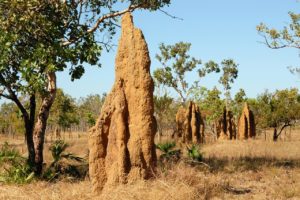Termites can help parched plants withstand climate change
 10 Maret 2020
10 Maret 2020
Not many people are fond of termites as they can destroy wooden houses and chew up wooden furniture. Pests they can be, all right.
Yet termites can also be important for ecosystems in semi-arid lands like grasslands and savannas where they can help plants withstand climate change, according to a study.
A warming climate is causing many grasslands to become even dryer, which is a problem since drier lands are especially climate-sensitive. As global warming is expected to intensify droughts in coming years, grasslands and savannas will face increased threats of desertification.
The transition of semi-arid areas driven by climate change is being studied by scientists, some of whom are predicting that northeast Brazil, which is currently covered by dry shrub-land vegetation, could soon shift into a desert landscape.
This is where those pesky termites enter the picture.
In a recent study published in the journal Science, researchers from Princeton University report that in dry lands termite mounds provide oases for vegetation that grows around the mounds. These towering mounds could possibly assist plants in becoming more resilient to climate change, the experts say.
Termites skillfully build intricate porous nests from earth. These structures allow rainwater to seep in and penetrate deep underground. Internal pores also cause less evaporation to occur than on the surface of the soil.

“The rain is the same everywhere, but because termites allow water to penetrate the soil better, the plants grow on or near the mounds as if there were more rain,” said Corina Tarnita, one of the authors behind the research who is an assistant professor of ecology and evolutionary biology at Princeton.
During especially arid periods when dry areas are hit with heatwaves and face a scarcity of water, most vegetation dries out. Not plants growing near termite mounds, however. Thanks to moisture preserved by these high-rise nests, adjacent plants can remain robust.
“Even when you see desertification start to happen between the mounds, the vegetation on or around the mounds is doing so well it will keep reseeding the environment,” Tarnita said.
“The vegetation on and around termite mounds persists longer and declines slower,” she further explained. “Even when you get to such harsh conditions where vegetation disappears from the mounds, re-vegetation is still easier. As long as the mounds are there the ecosystem has a better chance to recover.”
In our eyes termites may be troublesome, but in ecological terms they could do a world of good for vegetation by helping buffer some plants against climate change.
The post Termites can help parched plants withstand climate change appeared first on Sustainability Times.
